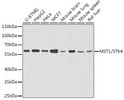| Tissue Specificity | Expressed in prostate cancer and levels increase from the normal to the malignant state (at protein level). Ubiquitously expressed. |
| Post Translational Modifications | Autophosphorylated on serine and threonine residues. Phosphorylation at Thr-387 by PKB/AKT1, leads to inhibition of its: kinase activity, nuclear translocation and autophosphorylation at Thr-183. It also diminishes its cleavage by caspases and its ability to phosphorylate FOXO3. Proteolytically cleaved by caspase-3 during apoptosis at Asp-326 and Asp-349 resulting in a 37 kDa or a 39 kDa subunit respectively. The 39 kDa subunit is further cleaved into the 37 kDa form. Proteolytic cleavage results in kinase activation and nuclear translocation of the truncated form (MST1/N). It is less likely that cleavage at Asp-349 is a prerequisite for activation as this site is not conserved in the murine ortholog. |
| Function | Stress-activated, pro-apoptotic kinase which, following caspase-cleavage, enters the nucleus and induces chromatin condensation followed by internucleosomal DNA fragmentation. Key component of the Hippo signaling pathway which plays a pivotal role in organ size control and tumor suppression by restricting proliferation and promoting apoptosis. The core of this pathway is composed of a kinase cascade wherein STK3/MST2 and STK4/MST1, in complex with its regulatory protein SAV1, phosphorylates and activates LATS1/2 in complex with its regulatory protein MOB1, which in turn phosphorylates and inactivates YAP1 oncoprotein and WWTR1/TAZ. Phosphorylation of YAP1 by LATS2 inhibits its translocation into the nucleus to regulate cellular genes important for cell proliferation, cell death, and cell migration. STK3/MST2 and STK4/MST1 are required to repress proliferation of mature hepatocytes, to prevent activation of facultative adult liver stem cells (oval cells), and to inhibit tumor formation. Phosphorylates 'Ser-14' of histone H2B (H2BS14ph) during apoptosis. Phosphorylates FOXO3 upon oxidative stress, which results in its nuclear translocation and cell death initiation. Phosphorylates MOBKL1A, MOBKL1B and RASSF2. Phosphorylates TNNI3 (cardiac Tn-I) and alters its binding affinity to TNNC1 (cardiac Tn-C) and TNNT2 (cardiac Tn-T). Phosphorylates FOXO1 on 'Ser-212' and regulates its activation and stimulates transcription of PMAIP1 in a FOXO1-dependent manner. Phosphorylates SIRT1 and inhibits SIRT1-mediated p53/TP53 deacetylation, thereby promoting p53/TP53 dependent transcription and apoptosis upon DNA damage. Acts as an inhibitor of PKB/AKT1. Phosphorylates AR on 'Ser-650' and suppresses its activity by intersecting with PKB/AKT1 signaling and antagonizing formation of AR-chromatin complexes. |
| Protein Name | Serine/Threonine-Protein Kinase 4Mammalian Ste20-Like Protein Kinase 1Mst-1Ste20-Like Kinase Mst1Serine/Threonine-Protein Kinase Krs-2 Cleaved Into - Serine/Threonine-Protein Kinase 4 37kda SubunitMst1/N - Serine/Threonine-Protein Kinase 4 18kda SubunitMst1/C |
| Database Links | Reactome: R-HSA-2028269 |
| Cellular Localisation | CytoplasmNucleusThe Caspase-Cleaved Form Cycles Between The Nucleus And Cytoplasm |
| Alternative Antibody Names | Anti-Serine/Threonine-Protein Kinase 4 antibodyAnti-Mammalian Ste20-Like Protein Kinase 1 antibodyAnti-Mst-1 antibodyAnti-Ste20-Like Kinase Mst1 antibodyAnti-Serine/Threonine-Protein Kinase Krs-2 Cleaved Into - Serine/Threonine-Protein Kinase 4 37kda Subunit antibodyAnti-Mst1/N - Serine/Threonine-Protein Kinase 4 18kda Subunit antibodyAnti-Mst1/C antibodyAnti-STK4 antibodyAnti-KRS2 antibodyAnti-MST1 antibody |
Information sourced from Uniprot.org







![Western blot analysis of lysates from wild type (WT) and MST1/STK4 knockout (KO) HeLa cells, using [KO Validated] MST1/STK4 Rabbit polyclonal antibody (STJ11100073) at 1:1000 dilution. Secondary antibody: HRP Goat Anti-Rabbit IgG (H+L) (STJS000856) at 1:10000 dilution. Lysates/proteins: 25 Mu g per lane. Blocking buffer: 3% nonfat dry milk in TBST. Detection: ECL Basic Kit. Exposure time: 1s. Western blot analysis of lysates from wild type (WT) and MST1/STK4 knockout (KO) HeLa cells, using [KO Validated] MST1/STK4 Rabbit polyclonal antibody (STJ11100073) at 1:1000 dilution. Secondary antibody: HRP Goat Anti-Rabbit IgG (H+L) (STJS000856) at 1:10000 dilution. Lysates/proteins: 25 Mu g per lane. Blocking buffer: 3% nonfat dry milk in TBST. Detection: ECL Basic Kit. Exposure time: 1s.](https://cdn11.bigcommerce.com/s-zso2xnchw9/images/stencil/600x533/products/89143/357593/STJ11100073_1__61039.1713121731.jpg?c=1)


